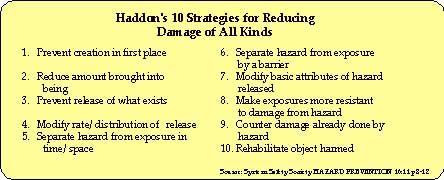|
|
INVESTIGATION CATALYST Recommendation Developmen Tutorial © 2004 by Starline Software Ltd. |
|
RISK REDUCTION STRATEGIES
General Strategies for developing recommendations to reduce future risks of inferior or undesired process performance and outcomes are offered as thought starters to help identify kinds of changes that might be considered to develop candidate changes. |
| Prepare Behaviors | People respond more predictably when they experience something they have lived through successfully than when they encounter a surprise for the first time and have to react by thinking their way through it or react instinctively. Thus a general strategy for improving future behaviors is to try to anticipate future surprises during a system's operation, and "walk through" the surprise on paper or drills with people who might have to deal with it in the future. The goal is to shift peoples' behavior from an unpredictable adaptive mode to a more predictable habituated mode. |
| Manage Energies | William Haddon, the first administrator of the U. S. National Highway Traffic Safety Administration propounded a set of strategies for controlling damage due to energy exchanges (work done by energies.) His strategies focused on managing energies, like preventing their creation, reducing the amount brought into being, etc. and led to collapsible automobile steering columns, seat belts and air bags, crushable front ends, and other automotive safety improvements over time.  Used in combination with the Energy Trace and Barrier Analysis tool, it can lead investigators with imagination to a wide range of options for changes in people, objects or energies that might be introduced into the production process. |
| Establish Precedences |
Another approach to identifying options to improve future performance by reducing risks is to apply the order of precedence or preference used by System Safety analysts for hazard controls:
|
| Control Interactions |
Use the M O T E L acronym in reverse for thought starters about how to help control future interactions by changing their
|
|
For an extended discussion of the recommendation development process, review the Starline guide at: http://www.starlinesw.com/product/Guides/MESGuide08.html. |